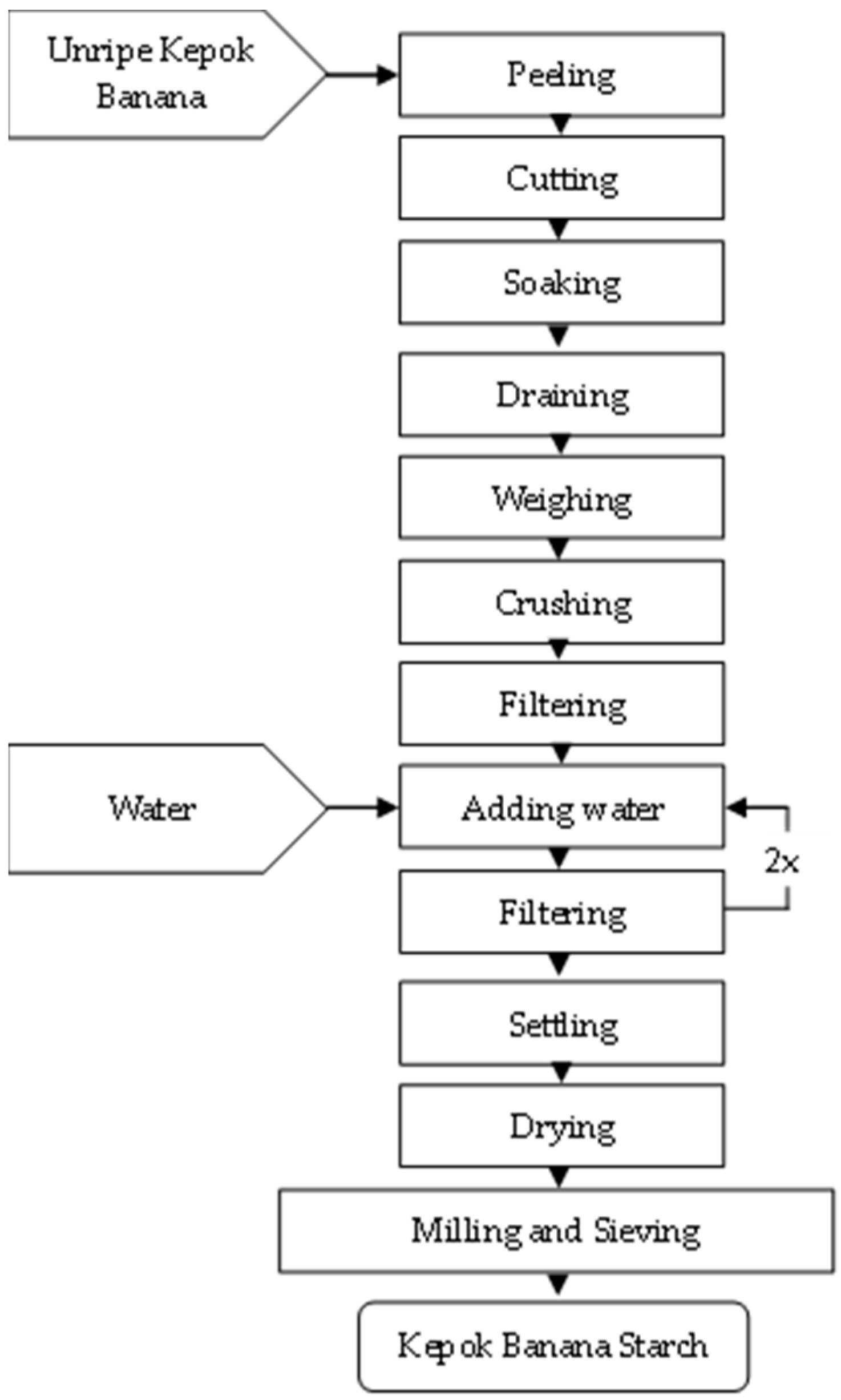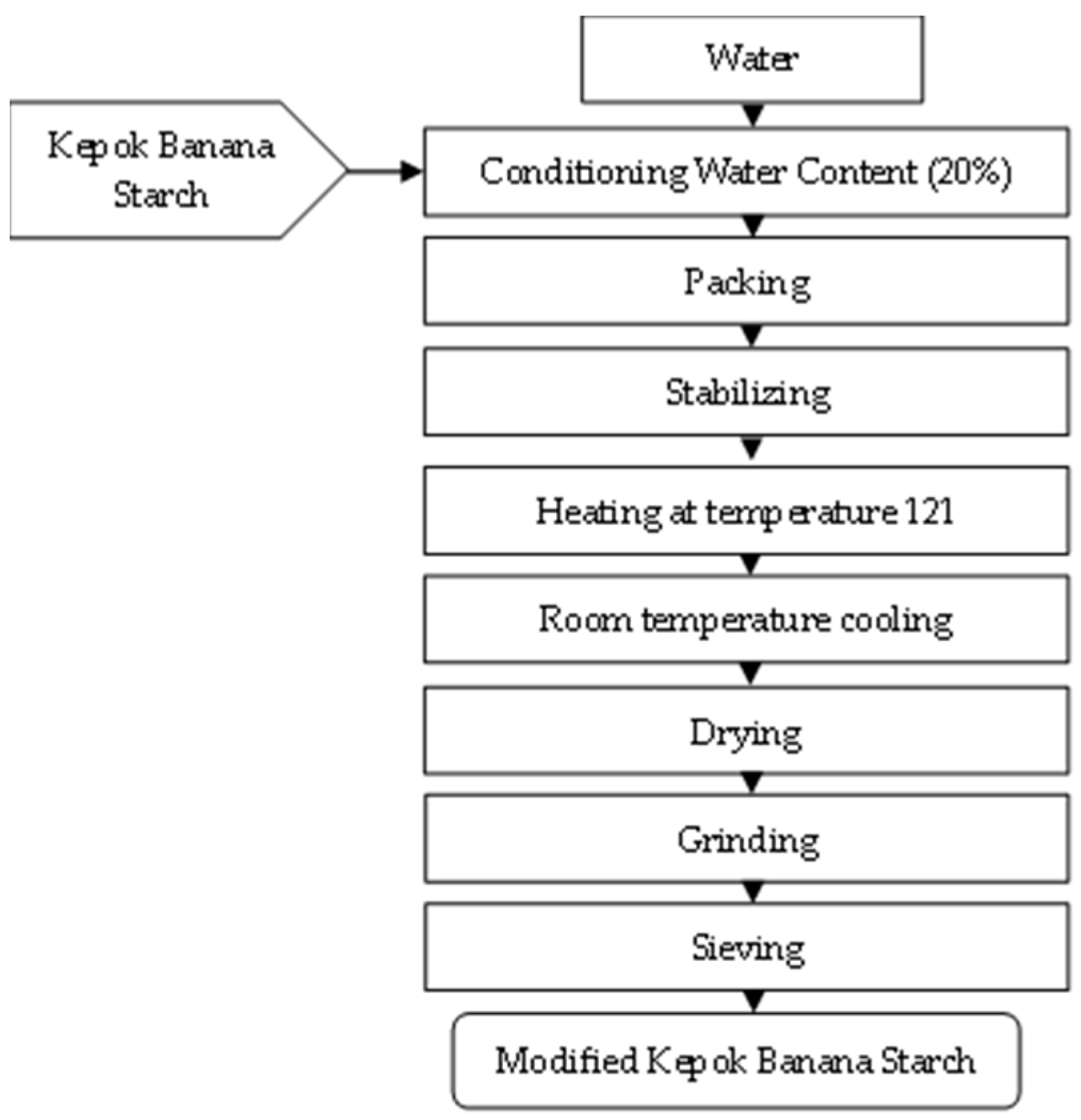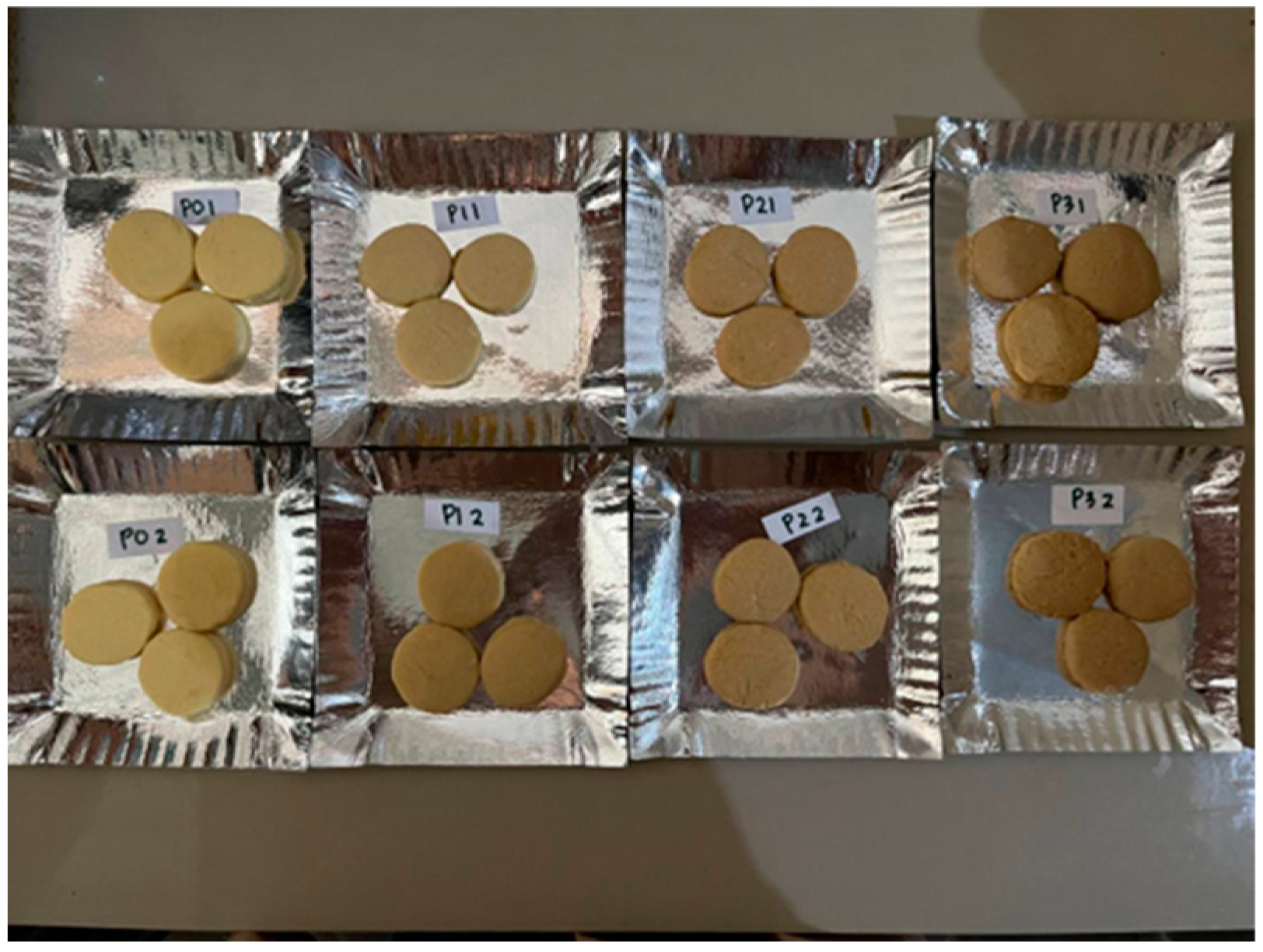The Effect of Modified Kepok Banana (Musa acuminata × balbisiana) Starch Substitution on the Fat, Dietary Fiber, and Resistant Starch Content of Product Cookies †
Abstract
1. Introduction
2. Materials and Methods
2.1. Types and Research Design
2.2. Time and Place of Research
2.3. Tools and Materials
2.4. Research Stages
2.4.1. Process for Making Modified Kepok Banana Starch
2.4.2. Process of Making Cookies
2.4.3. Testing
2.5. Statistical Analysis
3. Result and Discussion
3.1. Fat Content
3.2. Dietary Fiber
3.3. Resistant Starch
4. Conclusions
Author Contributions
Funding
Institutional Review Board Statement
Informed Consent Statement
Data Availability Statement
Acknowledgments
Conflicts of Interest
References
- Basic Health Research. Basic Health Research Results 2018; Health Research and Development Agency: Jakarta, Indonesia, 2018. [Google Scholar]
- PERKENI. Guidelines for Management and Prevention of Adult Type 2 Diabetes Mellitus in Indonesia 2021; PB PERKENI: Jakarta, Indonesia, 2021; 46p. [Google Scholar]
- International Diabetes Federation. IDF Diabetes Atlas, 10th ed.; Diabetes Research and Clinical Practice: Oxford, UK, 2021; Available online: www.diabetesatlas.org (accessed on 1 June 2023).
- Freeman, A.M.; Acevedo, L.A.; Penning, N. Insulin Resistance; StatPearls Publishing: Treasure Island, FL, USA, 2023. Available online: https://www.ncbi.nml.gov/books/NKB507834 (accessed on 1 June 2023).
- Nur, A.; Fitria, E.; Zulhaida, A.; Hanum, S. The Relationship between Consumption Patterns and Type 2 Diebetes Mllitus at RSUD dr. Fauziah Bireuen, Aceh. Health Res. Dev. Media 2017, 26, 145–150. [Google Scholar]
- Nuzulla, N.H. Description of Fast Food Consumption and Physical Activity in Type 2 Diabetes Mellitus Outpatients at RSNU Tuban. 2022. Available online: http://eprints.ums.ac.id/id/eprint/105566 (accessed on 1 June 2023).
- Susanti; Bistara, D.N. Relationship between Eating Patterns and Blood Sugar Lvels in Diabetes Mellitus Sufferers. Vocasional Health J. 2018, 3, 29–34. [Google Scholar]
- BPOMRI Regulation of the Head of the Food and Drug Supervisory Agency of the Republic of Indonesia. In Number HK.03.1.23.11.11.09909 of 2011 concerning Supervision of Claims in Processed Food Advertising Labels; BPOM RI: Jakarta, Indonesia, 2011; pp. 1–46.
- Pratiwi, Y.N.; Nurhayati, N.; Nafi, A. Evaluation of the Prebiotic Properties of Insoluble Dietary Fiber (IDF) Extracted from Flour of Agung Banana and Mas Banana. Agrotechnol. J. 2012, 6, 10–11. [Google Scholar]
- Setiarto, R.H.B.; Widhyastuti, N.; Saskiawan, I.; Safitri, R.M. Effect of Varying Inulin Concentrations on the Fermentation Process by Lactobacillus acidophilus, Lactobacillus bulgaricus and Streptococcus thermophilus. Biopropal. Ind. 2017, 8, 1–17. [Google Scholar]
- Millati, T.; Nurhayati, N. Making Rice Starch Resistant Starch Using Enzymatic and Physical Methods. Agrotech. Ummat. J. 2020, 7, 110–121. [Google Scholar] [CrossRef]
- Hassan, Z.H. Various Flours Based on Local Raw Materials as a Functional Food Source in an Effort to Increase the Added Value of Local Food Products. Food 2014, 23, 93–107. [Google Scholar]
- Musita, N. Banana Resistant Starch. Ind. Technol. Agric. Prod. 2009, 14, 68–79. [Google Scholar]
- Yusrina, F.; Puspitasari, R.; Widyaningsih, T.D.; Wulan, S.N. Improvement of Glycemic Response and Lipid Profile after Consuming Modified Raw Banana Flour. Indones. J. Hum. Nutr. 2020, 7, 92–107. [Google Scholar] [CrossRef]
- Psichas, A.; Sleeth, M.L.; Murphy, K.G.; Brooks, L.; Bewick, G.A.; Hanyaloglu, A.C.; Ghatei, M.A.; Bloom, S.R.; Frost, G. The Short Chain Fatty Acid Propionate Stimulates GLP-1 and PYY Secretion Via Free Fatty Acid Receptor 2 in Rodents. Int. J. Obessity 2015, 39, 424–429. [Google Scholar] [CrossRef]
- Christiansen, C.B.; Gabe, M.B.N.; Svendsen, B.; Dragsted, L.O.; Rosenkilde, M.M.; Holst, J.J. The Impact of Short-Chain Fatty Acids on GLP-1 and PYY Secretion from the Isolated Perfused Rat Colon. Am. J. Physiol.-Gastrointest Liver Physiol. 2018, 315, G53–G65. [Google Scholar] [CrossRef]
- Tang, R.; Li, L. Modulation of Short-Chain Fatty Acids as Potential Therapy Method for Type 2 Diabetes Mellitus. Can. J. Infect. Dis. Med. Microbiol. 2021, 2021, 6632266. [Google Scholar]
- Zhang, L.; Ouyang, Y.; Li, H.; Shen, L.; Ni, Y.; Fang, Q.; Wu, G.; Qian, L.; Xiao, Y.; Zhang, J.; et al. Metabolic phenotypes and the gut microbiota in response to dietary resistant starch type 2 in normal-weight subjects: A randomized crossover trial. Sci. Rep. 2019, 9, 4736. [Google Scholar] [CrossRef] [PubMed]
- Bimo Setiarto, R.H.; Laksmi Jenie, B.S.; Faridah, D.N.; Saskiawan, I. Study of Development Resistant Starch Contained in Food Ingredients as Prebiotic Source. J. Ilmu Pertan. Indones. 2015, 20, 191–200. [Google Scholar] [CrossRef]
- Wahyuni, P.T.; Syauqy, A. The Effect of Giving Banana Kepok (Musa paradisiaca forma typical) on Fasting Blood Glucose Levels in Sprague Dawley Rats with Pre-Metabolic Syndrome. J. Nutr. Coll. 2015, 4, 547–556. [Google Scholar] [CrossRef]
- Wahab, Z.; Novitasari, A. WNF Lipid Profile as Glycemic Control in Type II Diabetes Mellitus Patients. Muhammadiyah Med. J. 2015, 4, 1–10. [Google Scholar]
- Lee, J.S.; Yusoff, N.D.; Ho, A.L.; Siew, C.K.; Akanda, J.H.; Tan, W.X. Quality Improvement of Green Saba Banana Flour Steamed Cake. Appl. Sci. 2023, 13, 2421. [Google Scholar] [CrossRef]
- Putri, C.Y.K.; Pranata, F.S.; Swasti, Y.R. Quality Muffins with a Combination of White Kepok Banana Flour (Musa paradisiaca forma typica) and Yellow Pumpkin Flour (Cucurbita moschata). Biota Sci. J. Life Sci. 2019, 4, 50–62. [Google Scholar]
- Soviana, E.; Maenasari, D. Fiber Intake, Glycemic Load and Blood Glucose Levels in Type 2 Diabetes Mellitus Patients. Health J. 2019, 12, 19–29. [Google Scholar]
- Chen, C.; Zeng, Y.; Xu, J.; Zheng, H.; Liu, J.; Fan, R.; Zhu, W.; Yuan, L.; Qin, Y.; Chen, S.; et al. Therapeutic Effects of Soluble Dietary Fiber Consumption on Type 2 Diabetes Mellitus. Exp. Ther. Med. 2016, 12, 1232–1242. [Google Scholar] [CrossRef]
- Syafii, F.; Fajriana, H. Formulation for Making Biscuits with Substitution of Modified Kepok Banana Flour (Musa paradisiaca). J. Agritech. Sci. 2022, 6, 1–10. [Google Scholar] [CrossRef]
- Ministry of Agriculture. Food Consumption Statistics for 2022; Center for Agricultural Data and Information Systems, Secretariat General of the Ministry of Agriculture: Jakarta, Indonesia, 2022.
- Musita, N. Study of the Content and Characteristics of Resistant Starch from Various Banana Varieties. J. Din. Penelit. Ind. 2012, 23, 57–65. [Google Scholar]
- Pratama, M.A.; Nendra, H. Physical, Chemical and Organoleptic Properties of Cookies with the Addition of White Kepok Banana Flour. 2017; pp. 584–591. Available online: http://research-report.umm.ac.id/index.php/research-report/article/view/1271 (accessed on 1 June 2023).
- AOAC. Official Methods of Analysis, 16th ed.; Association of Official Analytical Chemists: Washington DC, USA, 1995. [Google Scholar]
- Englyst, H.N.; Cummings, J.H. Non-Starch Polysaccharides (Dietary Fiber) and Resistant Starch. In New Developments in Dietary Fiber; Springer: Boston, MA, USA, 1990; pp. 205–225. [Google Scholar]
- Marta, H.; Cahyana, Y.; Djali, M.; Arcot, J.; Tensiska, T. A Comparative Study on The Physicochemical and Pasting Properties of Starch and Flour from Different Bananas (Musa spp.) Cultivars Grown in Indonesia. Int. J. Food Prop. 2019, 22, 1562–1575. [Google Scholar] [CrossRef]
- TKPI. Indonesian Food Composition Table 2017; Indonesian Ministry of Health, Directorate General of Public Health: Jakarta, Indonesia, 2018. [Google Scholar]
- Ayu, S.M.; Matkhir, A.A.; Akanda, J.H.; Mamat, H.; Hamid, M.A. The Effects of Unripe Saba Banana Composite Flour on Acceptance and Physicochemical Characteristic of Biscuits. Sci. Res. J. 2021, 18, 55–79. [Google Scholar]
- Mahendradatta, M.; Laga, A.; Nurhisna, N.I.U. Study of Snack Bar Combination of Banana Flour (Musa paradisiaca) and Mung Bean Flour Blending as Emergency Food. IOP Conf. Ser. Earth Environ. Sci. 2020, 486, 012054. [Google Scholar] [CrossRef]
- SNI 2973:2011; Biscuit. National Standardization Agency: Jakarta, Indonesia, 2011.
- BPOM RI. Food and Drug Supervisory Agency Regulation Number 1 of 2018 concerning Supervision of Processed Food for Special Nutritional Needs; BPOM RI: Jakarta, Indonesia, 2018. [Google Scholar]
- Ramadhani, Z.O.; Dwiloka, B.; Pramono, Y.B. Effect of Substituting Wheat Flour with Kepok Banana Flour (Musa Acuminata L.) on Protein Content, Fiber Content, Expanding Power, and Hedonic Quality of Steamed Cake. J. Food Technol. 2019, 3, 80–85. [Google Scholar]
- Syafii, F.; Fajriana, H. Formulation High Fiber Cookies Using Modified Banana Flour (Musa paradisiaca). In Proceedings of the 3rd International Conference on Urban Health, the COVID-19 Pandemic and Urban Health Issues, Makassar, Indonesia, 21–22 September; 2021; pp. 64–71. Available online: https://journal.poltekkes-mks.ac.id/ojs2/index.php/Prosiding/article/view/2471/1706 (accessed on 1 June 2023).
- Afifah, D.N.; Sari, L.N.I.; Sari, D.R.; Probosari, E.; Wijayanti, H.S.; Anjani, G. Analysis of Nutrient Content, Resistant Starch, Glycemic Index, Glycemic Load and Acceptability of Cookies with Enzymatically Modified Kepok Banana Flour (Musa paradisiaca) and Mung Bean Flour (Vigna radiate). J. Food Technol. Appl. 2020, 9, 101–107. [Google Scholar]



| Materials | Composition (Grams) | |||
|---|---|---|---|---|
| P0 | P1 | P2 | P3 | |
| flour | 100 | 75 | 50 | 25 |
| modified Kepok banana starch | 0 | 25 | 50 | 75 |
| tapioca flour | 5 | 5 | 5 | 5 |
| sugar | 40 | 40 | 40 | 40 |
| skimmed milk | 10 | 10 | 10 | 10 |
| egg | 20 | 20 | 20 | 20 |
| baking powder | 1 | 1 | 1 | 1 |
| salt | 0.5 | 0.5 | 0.5 | 0.5 |
| margarine | 45 | 45 | 45 | 45 |
| total | 221.5 | 221.5 | 221.5 | 221.5 |
| Treatment | Fat Content | p Value |
|---|---|---|
| P0 (0%) | 17.06 ± 0.52 a | 0.000 |
| P1 (25%) | 18.11 ± 0.50 b | |
| P2 (50%) | 19.19 ± 0.14 c | |
| P3 (75%) | 19.63 ± 0.21 c |
| Treatment | Dietary Fiber Content | p Value |
|---|---|---|
| P0 (0%) | 9.75 ± 0.10 a | 0.003 |
| P1 (25%) | 11.83 ± 0.58 ab | |
| P2 (50%) | 13.48 ± 0.45 ab | |
| P3 (75%) | 14.30 ± 0.04 b |
| Treatment | Resistant Starch Content | p Value |
|---|---|---|
| P0 (0%) | 8.12 ± 0.48 a | 0.000 |
| P1 (25%) | 9.76 ± 0.66 b | |
| P2 (50%) | 10.88 ± 0.55 c | |
| P3 (75%) | 11.84 ± 0.36 d |
Disclaimer/Publisher’s Note: The statements, opinions and data contained in all publications are solely those of the individual author(s) and contributor(s) and not of MDPI and/or the editor(s). MDPI and/or the editor(s) disclaim responsibility for any injury to people or property resulting from any ideas, methods, instructions or products referred to in the content. |
© 2024 by the authors. Licensee MDPI, Basel, Switzerland. This article is an open access article distributed under the terms and conditions of the Creative Commons Attribution (CC BY) license (https://creativecommons.org/licenses/by/4.0/).
Share and Cite
Azizah, N.; Sofyan, A. The Effect of Modified Kepok Banana (Musa acuminata × balbisiana) Starch Substitution on the Fat, Dietary Fiber, and Resistant Starch Content of Product Cookies. Eng. Proc. 2024, 63, 7. https://doi.org/10.3390/engproc2024063007
Azizah N, Sofyan A. The Effect of Modified Kepok Banana (Musa acuminata × balbisiana) Starch Substitution on the Fat, Dietary Fiber, and Resistant Starch Content of Product Cookies. Engineering Proceedings. 2024; 63(1):7. https://doi.org/10.3390/engproc2024063007
Chicago/Turabian StyleAzizah, Nain, and Aan Sofyan. 2024. "The Effect of Modified Kepok Banana (Musa acuminata × balbisiana) Starch Substitution on the Fat, Dietary Fiber, and Resistant Starch Content of Product Cookies" Engineering Proceedings 63, no. 1: 7. https://doi.org/10.3390/engproc2024063007
APA StyleAzizah, N., & Sofyan, A. (2024). The Effect of Modified Kepok Banana (Musa acuminata × balbisiana) Starch Substitution on the Fat, Dietary Fiber, and Resistant Starch Content of Product Cookies. Engineering Proceedings, 63(1), 7. https://doi.org/10.3390/engproc2024063007






